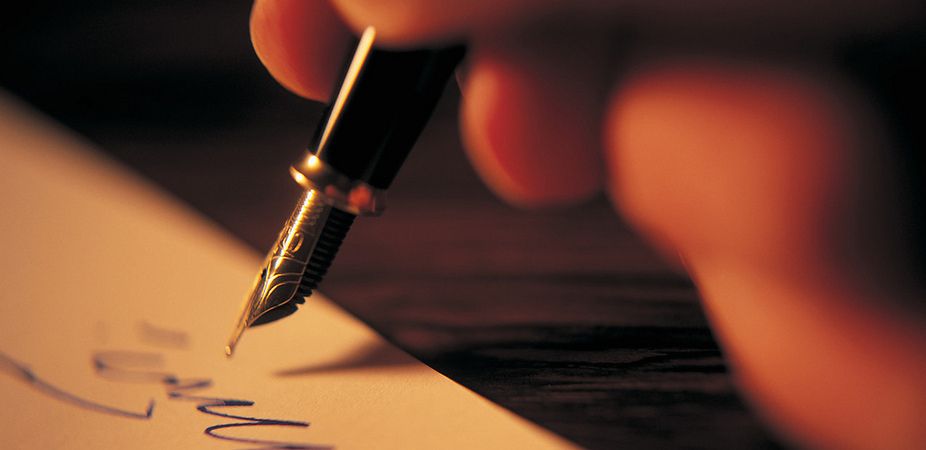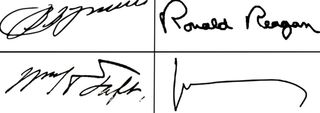
This article was originally published at The Conversation. The publication contributed the article to LiveScience's Expert Voices: Op-Ed & Insights.
Have you ever had your credit card stolen and used? Did the thief try to forge your scrawled signature, miniaturised on that impossibly tiny and slippery white line on the back of your card?
I once had my credit card stolen and within minutes it had been used at a nearby supermarket to buy bottles of whiskey and shaving cream. It made me take a good look at my signature and question how hard it really was to forge.
People think signatures are used less today in place of personal identification numbers (PINs) and PayWave, and at point of sales they are – yet our signatures are still heavily relied upon for many financial and legal transactions.
The signature is an artifact that remains as testament to one’s consent and decision to complete a deal – be it a sale, a binding contract, an authorisation, or something else.
The potential for misuse and abuse of signatures in the form of signature forgery is just as much a threat today as it was prior to PINs and PayWave. However, today we know much more about the humble signature and what helps to make a signature harder for a would-be forger to copy.
Taking a closer look
How forgeable do you think your signature is? Was it something you considered when you first started signing your signature? What aspects do you think make a signature more or less easily forgeable?
Sign up for the Live Science daily newsletter now
Get the world’s most fascinating discoveries delivered straight to your inbox.
When a signature is contested, an expert signature analysis, or forensic document examiner, is called upon to give their expert opinion on the likelihood that the contested signature is a forgery, disguised or in fact a genuine.

These experts are trained in the theory and practice of forgery detection, which over the past 15 years has been bolstered by detailed scientific examination of forgers' techniques and underpinning theory.
Until recently there had not been the same consideration given to examining what made signatures easier or harder to forge – information that could be useful to the average person to consider when looking at their own signature or redesigning a more robust one – as well as to the document examiner.
In a recent set of studies in our lab, we closely examined the process of signature forgery with the goal to learn more about what makes a signature harder to forge.
In particular we were interested to see which elements of a signature add increasing levels of difficulty – making it not only harder to be forged, but also easier for a forensic document examiner to form a strong and reliable opinion.
We ran a number of experiments from surveys to eye-tracking studies. In an online survey we asked 63 people to rate how hard they thought 12 signatures would be to copy. They then had to try to copy each signature and re-valuate their opinion as well as tell us which parts of the signature they found hardest to complete.
Further we then tested 20 people in the lab as they attempted to copy two signatures. As they copied them we recorded their dynamic hand motion using a digitising pad, as well as their eye movements.
What makes a signature hard to forge?
So what did we find out about what makes a signature hard to forge? Through the survey we found that:
- Signatures that are illegible tend to be more difficult to forge than those legible
- A signature with more line intersection and with more turning points (changes in pen direction) is more difficult to forge
- The presence of abnormal line directions (such as moving counter clockwise for an “o”) can make a signature more difficult to forge.
Through the eyes of a forger
Using eye tracking we also found that the eye movements made while copying gave clues about what forgers considered difficult.
Forgers spent more time looking at difficult signatures rather than their forgery attempt, meaning that their reproduction, which they hardly looked at and which was written relatively slowly, was not produced very well.
The difficulty of a signature meant that a lot of their cognitive resources were going into figuring out the signature, rather than getting their reproduction right.
Another interesting finding was that we saw that the harder the signature was, the more often the subjects pupils would dilate – a factor that may come in handy one day. If eye tracking is ever included in the signing procedure, a lot of dilation may indicate a suspicious attempt.

Tips for your signature
So how could you take any of that on board and make your signature more forge-proof? You can:
- make sure your signature is complex enough – maybe containing elements that are not legible and or that contain pen strokes that are counter intuitive
- ensure that it is produced fast and fluidly (don’t write it slowly like text)
- try to be consistent when you sign your signature – don’t make it a carbon copy each time, but keeping it generally similar each time is the key.
So take note of these points within your signature and you might just make your signature a little less vulnerable to being forged.
The authors do not work for, consult to, own shares in or receive funding from any company or organisation that would benefit from this article. They also have no relevant affiliations.
This article was originally published at The Conversation. Read the original article. The views expressed are those of the author and do not necessarily reflect the views of the publisher. This version of the article was originally published on LiveScience.




